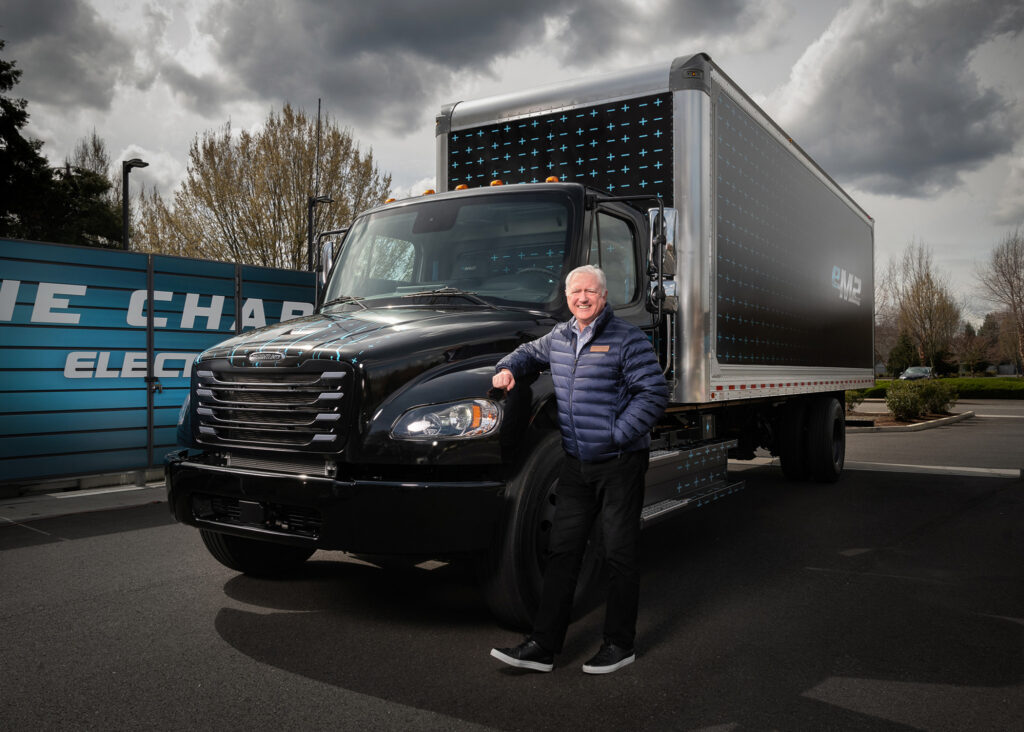Battery supplies, charging infrastructure are lacking: O’Leary
Battery-electric vehicles are proving their worth, but the head of North America’s largest truck manufacturer recognizes significant gaps that remain in battery supply chains and charging infrastructure alike.
“There’s really no battery industry to speak of,” Daimler Truck North America president and CEO John O’Leary said during a media briefing at ACT Expo in California. “There’s a lot of ideas, there’s a lot of press releases, a lot of even shovels in the ground in some places. But as far as actual output, of mass production, of batteries ready for action for installation and vehicles, [it’s] very minimal.”
When it comes to establishing additional production capacity, many people overlook the underlying supply chain needed to provide battery cells and controllers, he added.

That’s only one limitation. Such batteries still require charging infrastructure, and the OEM executive said this remains a limiting factor for broader battery-electric vehicle rollouts, citing backorders for switching gear and other substation components that extend two to three years.
“You may have the ultimate desire to install a big charging station next year, but the odds are it’s probably going to be two or three years unless you just get lucky in terms of where some existing power happens to be.”
US$52 billion investment needed
Customers simply can’t find the charging infrastructure they need, he continued during a keynote presentation later in the day. “Infrastructure buildouts are flailing, and we’re destined to fail to meet the ambitious goals of the state, of our country, and the world, until emphasis is put on meeting the charging needs of the electric fleet.
“The nation’s fleet can’t achieve the desired reduction in emissions, nor can they realize the usefulness of these [electric trucks], if they can’t charge where those vehicles are domiciled.”
Nationwide 2032 climate targets will require US$52 billion in investments for the energy generation, transmission, and distribution to support medium-duty and heavy-duty vehicles, according to Daimler Truck calculations. And that’s not counting the real estate investments to site the chargers. California’s rules alone will require 30 new DC chargers per day in the years leading to 2026, while the Advanced Clean Trucks rule will require the state to add 5 million kilowatts of installed capacity by 2035.
“If we ignore this reality, if we ignore the energy demand, if we ignore the differences in charging needs, we’re going to find a lot of orphaned equipment sitting at depots or sitting idle,” he said.
Hydrogen options
Discussions about decarbonizing vehicles are extending beyond battery-electric equipment, of course, and O’Leary said during the media briefing that the options for hydrogen have expanded in the last 18 months.
“Hydrogen is going to be a viable solution,” he said, referring specifically to longhaul applications. “Batteries are limited just from their pure physics at least unless there’s a massive breakthrough that nobody sees coming. You’re not going to run a battery 1,000 miles (1,600 km) — not with 80,000 lb. pulled behind it and going up and down mountains.”
It’s still unknown whether fuel cells or hydrogen fed into an internal combustion engine will take the lead here, but Daimler is researching both.
A hydrogen option will likely emerge at higher volumes late in 2028/29, O’Leary predicted. But even there, infrastructure challenges persist.
“There’s even less hydrogen fueling infrastructure in the U.S. right now than there is battery-electric,” he said. Unlike battery-electric infrastructure that relies on investments by private utility operators and municipalities, however, “big petrochemical behemoths” could move quickly. (“A heck of a lot faster and with a lot more money behind them.”)
“Cleaner choices – whether battery-electric, hydrogen fuel cell, or hydrogen combustion alternatives do exist. And for select applications, they can work today – but they are not the panacea we’ve been hoping for,” he told the crowd at his keynote address. “Allow me to share the stark reality that the vehicles are only one part of a three-pronged equation in facilitating an industry transformation. Beyond those promising alternatives, the total cost of ownership must be equal to or better than what is currently available. And infrastructure for refueling or recharging must be ubiquitous.”
A future for diesel
As far as alternative energy sources have come, though, Daimler isn’t ready to sound the death knell of diesel. Not yet. Diesel power will be part of the equation for awhile and will become even cleaner against a backdrop of coming emissions regulations, O’Leary said.
“I couldn’t tell you how many years [remain] for sure. We’ve said at least until 2039, and I know there’s certain parts of the country where in certain applications, and certain other aspects of the business where diesel will continue to make sense for quite awhile, so it’s not like we’re getting out of the diesel truck business.”
The OEM has already showcased related technologies in the SuperTruck II program, many of which will move from concept to on-road offering.
“Instead of generating headlines this week, instead of celebrating what has been delivered, instead of patting ourselves on the back, I encourage everyone here to join us and roll up our sleeves,” he charged the ACT Expo crowd. “Let’s be honest about the problems. Let’s drop the hyperbole.”
Have your say
This is a moderated forum. Comments will no longer be published unless they are accompanied by a first and last name and a verifiable email address. (Today's Trucking will not publish or share the email address.) Profane language and content deemed to be libelous, racist, or threatening in nature will not be published under any circumstances.